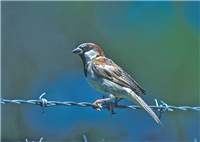Family
Passeridae
Genus
Passer
Species
domestica
Threats/Control Methods - Regional
House Sparrows pose a threat to the local woodland habitat, as they will eat the fruits and seeds of weed species, helping them to spread further out of control. They will also compete with native birds for nesting hollows.
Threats/Control Methods - Local
This species is very suited to the urban environment and is only at risk from predation by free-roaming pets or the aggressive White-browed Babblers (Pomatostomus superciliosus) who appear to want to help rid the suburbs of this introduced species.
Local/Urban Actions
Gardeners should ensure all weed species are removed from their yards and replaced with natives. Sparrows' nests should be removed if they are around the house, to allow other native species to use nesting sites.
Common Names
House Sparrow, English Sparrow
Distinguishing Features
House Sparrows are small birds, 14-16cm in size with a brownish appearance. The male has a grey crown and a black throat and breast. The back and feathers are red-brown with black markings and the underbelly and cheeks are white. The tail is fairly long, thin and grey. The female is much paler and the grey crown and black throat is simply a dull cream colour. Female bills are pale, while the male's changes from brown to black in the breeding season. Young birds are paler and scruffier in appearance.
Survey Techniques
Call and visual identification.
Species Call
A monotonus 'chirrup' or 'chissik' harsh chattering.
Similar Species
This species is very similar to the Tree Sparrow (Passer montanus) in Victoria, however the grey crown and black throat and breast are unique to House Sparrows.
Distribution
This species is currently confined to the eastern states of the states of Australia. Any species found in cities in WA have been destroyed to prevent the species from expanding in that region.
Country of Origin
The House Sparrow was introduced to Australia from Britain in the 1860s, first to Melbourne, then Sydney, Brisbane and Hobart.
Conservation (Pet/Pest) Status - Regional
Population numbers are high in the area, however numbers have slightly decreased in the last 20 years (COG), indicating the population is not a threat or pest species.
Conservation (Pet/Pest) Status - National
Introduced, widespread and abundant, with a moderate pest status.
LSCCES Population
Highest numbers were recorded in Turner, followed by Civic West and the NMA, with one found at ANU.
Associated vegetation community
The bird has become abundant in city areas, preferring the urban environment to the suburbs or bushland settings.
Limiting Resources
House Sparrows require buildings for nest holes and shelter. They all less limited by diet than many species, as they will eat almost anything.
Breeding
A breeding pair builds a large untidy ball of grass and feathers under rooves or in building crevices, under bridges or in tree hollows. The female will lay 3-6 eggs and incubate them for two weeks. Both parents will care for the young in the nest for another two weeks. In Canberra, most breeding activity takes place from October to January.
Behaviour
House Sparrows are noisy birds that spend their time in flocks up trees or on the ground. They hop around with drooping wings and flickering tails, pecking at seeds, insects and scraps. They roost communally under building eaves. Part or the breeding cycle includes a group display, where up to a dozen males chase a single female for over a minute, nicknamed a 'sparrow party'.
Functional Group
Food Species
This species will eat a wide array of foods including spiders and insects, seeds, flower buds, berries and human food scraps.
Predators
Due to the human environment being the preferred habitat for this species, it is most at risk from domestic pets such as Cats (Felis catus) and Dogs (Canis familiaris). Native have been known to destroy the nests of the House Sparrow, pulling out young birds.
Interesting Fact
The House Sparrow was originally bought to Australia to remind people of their European homeland. It quickly became a pest, with population numbers expanding rapidly. The government paid rewards for destroying the birds and their eggs, but no efforts were successful.
References - (reader suitability of references, P=Primary teachers, S=Secondary students, T=Tertiary students and researchers)
Books:Boles, W. 1988. The Robins and Flycatchers of Australia. Angus and Robertson Publishers. UK. P, S, T
Morcombe, M. 2000. Field Guide to Australian Birds. Steve Parish Publishing. Archerfield. Australia P, S, T
Schodde, R. and Tideman, S. (eds) 1990. Reader's Digest Complete Book of Australian Birds (2nd Edition). Reader's Digest Services Pty Ltd. Sydney. P, S, T
Veerman, P. 2003. Canberra Birds: A report on the first 21 years of the garden bird survey. Philip Veerman and Canberra Ornithologists Group. Canberra. S, T
Internet: Birds in Backyards 2006. [online]. Available at:http://www.birdsinbackyards.net P, S, T
Canberra Ornithological Group (COG). 2004. Birds of Canberra Gardens. COG and the ACT Department of Urban Services. [online]. Available at:http://garden.canberrabirds.org.au/ P, S, T
Online Publications:Nix, H. and Cunningham, R. 2006. Birds of the Lower Sullivans Creek Catchment, Canberra ACT. Prepared for the Life in the Suburbs project using data from the Lower Sullivans Creek Catchment Ecological Survey (LSCCES). Australian National University. Canberra. [online]. Available at: http://www.lifeinthesuburbs.com.au/category.php?id=65 S, T

 Top
Top Top
Top